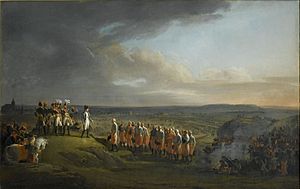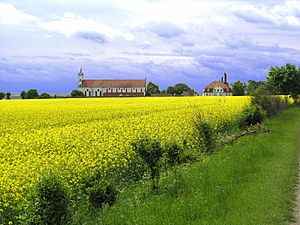Battle of Ulm facts for kids
Quick facts for kids Battle of Ulm |
|||||||
|---|---|---|---|---|---|---|---|
| Part of the Ulm campaign during the War of the Third Coalition | |||||||
 The Capitulation of Ulm, by Charles Thévenin |
|||||||
|
|||||||
| Belligerents | |||||||
| Commanders and leaders | |||||||
| Strength | |||||||
| 80,000 | 40,000 | ||||||
| Casualties and losses | |||||||
| 1,500 killed, wounded or captured | 4,000 killed or wounded 27,000 captured |
||||||
The Battle of Ulm took place from October 16 to 19, 1805. It was a series of smaller fights that happened at the end of the Ulm Campaign. This battle allowed Napoleon I to trap an entire Austrian army. The Austrian army was led by Karl Mack von Leiberich. Napoleon's forces surrounded them near Ulm in Bavaria. The French won with very few losses, forcing the Austrians to surrender.
What Led to the Battle?
In 1805, several powerful countries joined together. These included the United Kingdom, the Austrian Empire, Sweden, and the Russian Empire. They formed the Third Coalition. Their goal was to defeat the French Empire led by Napoleon.
When Bavaria decided to support Napoleon, the Austrians acted quickly. An Austrian army of 72,000 soldiers, led by General Mack, invaded too early. The Russian army, who were supposed to help, were still far away. They were marching through Poland. The Austrians thought the main battles would be in northern Italy, not Germany. They only wanted to protect the Alps mountains from French attacks.
Napoleon had a huge army of 177,000 soldiers, called the Grande Armée. They were waiting at Boulogne to invade England. But Napoleon changed his plans. On August 27, they marched south. By September 24, they were ready to cross the Rhine River into Germany.
After crossing the Rhine, most of the French army made a big turn. They moved so that their different groups reached the Danube River at the same time. They were now facing south. On October 7, General Mack found out Napoleon's plan. Napoleon wanted to cross the Danube and go around Mack's right side. This would cut off Mack from the Russian army, who were marching towards Vienna.
Mack quickly changed his army's position. He put his left side at Ulm and his right side at Rain. But the French kept moving. They crossed the Danube at several places like Neuburg and Donauwörth. The Austrian forces, led by Michael von Kienmayer, couldn't stop the French. They left their positions and fled towards Munich.
On October 8, a part of the Austrian army was attacked. This happened at the Battle of Wertingen. French cavalry and infantry defeated them. The next day, Mack tried to cross the Danube to move north. But he was defeated again at the Battle of Günzburg. French forces seized a bridge on the south bank of the river. Mack then went back to Ulm. He tried to break out to the north, but his army was stopped at the Battle of Haslach-Jungingen on October 11.
By October 11, Napoleon's army was spread out. They formed a wide net to trap Mack's army. Different French army groups moved to cut off the Austrians. Some went to cut off Mack from Tyrol. Others moved towards Munich. Meanwhile, French forces led by Joachim Murat, Michel Ney, and Jean Lannes began to close in on Ulm. Mack ordered one of his generals, Franz von Werneck, to march northeast. Another general, Johann Sigismund Riesch, was to protect his right side at Elchingen. Mack sent another group of soldiers south towards Tyrol. He kept the rest of his army at Ulm.
The Battle of Ulm
On October 14, General Ney's forces attacked General Riesch's small group at the Battle of Elchingen. Ney defeated them and chased the remaining soldiers back into Ulm. Meanwhile, Murat found Werneck's forces and chased them with his cavalry. Over the next few days, Werneck's army was defeated in several smaller fights. On October 18, he surrendered the rest of his troops. Only Archduke Ferdinand Karl Joseph of Austria-Este and a few other generals managed to escape. They got away to Bohemia with about 1,200 cavalry soldiers.
At the same time, another French general, Nicolas Soult, forced 4,600 Austrians to surrender at Memmingen. He then moved north to help trap Mack from the south. Another Austrian general, Franz Jellacic, managed to escape south. But he was later caught and captured in mid-November.
By October 16, Napoleon had completely surrounded Mack's entire army at Ulm. Four days later, on October 20, General Mack surrendered. He gave up with 25,000 men, 18 generals, 65 cannons, and 40 flags.
About 20,000 Austrian soldiers managed to escape. Around 10,000 were killed or wounded. The rest were taken prisoner. The French had very few losses. Only about 500 French soldiers were killed and 1,000 were wounded. This was a very low number for such a big victory. In less than 15 days, Napoleon's Grande Armée defeated 60,000 Austrians and 30 generals. When Mack surrendered, he offered his sword to Napoleon. He called himself "the unfortunate General Mack." Mack was later put on trial by his own country. He was sentenced to two years in prison.
What Happened Next?
The Ulm Campaign is seen as a great example of a strategic victory. This means Napoleon won by using smart plans, even though he had a much larger army. The campaign was won without one huge, bloody battle. The Austrians fell into the same kind of trap Napoleon had used before. But this time, the trap worked perfectly. Everything was done to confuse the enemy.
Napoleon himself spoke about the victory. In a message to his soldiers on October 21, 1805, he said: "Soldiers of the Grande Armée, I told you we would have a great battle. But thanks to the enemy's bad choices, I got the same success with no risk... In 15 days we have won a campaign."
By defeating the Austrian army at Ulm, Napoleon made it easier to capture Vienna. Vienna was the capital of Austria. The French army took it about a month later.
The Ulm Campaign is still studied in military schools around the world. It continues to influence military leaders even today. For example, the Schlieffen Plan, which Germany used at the start of World War I, was inspired by Napoleon's strategy at Ulm. It was designed to surround enemy troops. One military historian said that Ulm "was not a battle; it was a strategic victory so complete and so overwhelming that the issue was never seriously contested in tactical combat." He also said, "This campaign opened the most brilliant year of Napoleon's career. His army had been trained to perfection; his plans were faultless."






